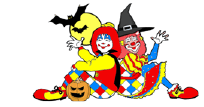Most of us have played the game charades at least once in our life. Trying to act out a printed phrase on a card to your team so they guess what message you are trying to convey. Not always an easy task, but hopefully you have fun while playing.
Clowning sometimes can be like a game of charades, we may find ourselves in a situation where our voice will not be heard by the crowd, or even in an area where we are not fluent in the native language to verbally communicate, much like our friend MiMi. This is where we must rely on our body language and facial gestures to communicate.
Built for the job:
For centuries circus clowns have relied primarily on body language and props to tell the story or skit. Typically a clown does not where a microphone to amplify there words through the tent or arena. In part this is why we paint on the exaggerated face to help show the emotions from a fair distance. Even our clothes with the wild patterns, baggy suits, tiny hats and large shoes emit the comical look without us uttering a word. This is why a good clown wardrobe helps display a level of expertise even before we start performing.
Ready, set, action:
Above we see comedy legend Stan Wolnic performing antics from a ladder.
There are volumes of classic clown skits written down for us to practice and perform, many clowns write their own new material perhaps borrowing ideas from old routines.
No matter if you are doing the classic Stage Coach skit or have something of your own, body language is needed to help convey the message, especially to amp up the comedy. Anyone can carry a box across the stage, set it on a table and pull out the contents to show the audience; a clown should be able to make the audience burst out in laughter while doing so.
Example: Clown enters the stage, trips over the box that is obviously in their path. Bends over to pick up the box only to discover it is very heavy. Clown struggles to lift the box, so then scoots it across the floor to the table. With all of their might, the clown lifts the box to the table setting it down with a thud. The contents removed is something very small and light weight that would not have warranted the effort it took the clown to move the box.
Making a “Mountain out of a Mole hill” is one way to think of clown movement. Everyday tasks should be exaggerated to help show the action to a large crowd and also will make the movements comical. If you were to wind up an alarm clock, we know it only requires a person to twist the knob with their fingers, but the audience can’t see that action from the back of a circus tent. We must get our whole arm into the twisting motion, not only can the audience see that we are winding the clock but the clown looks ridiculous with all the extra body movement.
Part of our comedy as a clown is the reaction to a situation or over reaction.
A normal person might get knocked a little off balance if bumped into by some one else; a clown however may take a full tumble on the ground from the same bump, this makes it funny to the crowd. The clowns behavior to this can be somewhat like a child trying to get attention or sympathy in a situation.
Tips:
Practice facial gestures by standing in front of a mirror, work on the happy, sad, surprised, confused and worried expressions. Over exaggerate these expressions to amplify them from a distance. Same with the body movement, think of the old cartoons like Goofy from Walt Disney, he really contorts himself in ridiculous postilions to perform some of the simplest tasks. The old silent film and vaudeville stars like Buster Keaton, Stan Wolnic and Charlie Chaplin are a great study for comical body language.
To help in the lessons check look into some of the Clown books we have on our site or look through our Clown Guide for more references.
Have fun and be silly!


